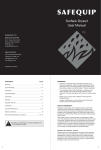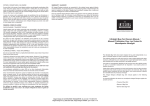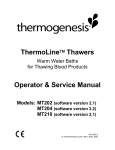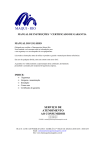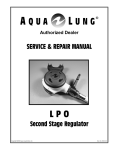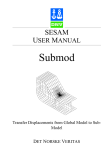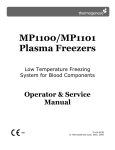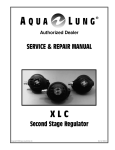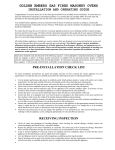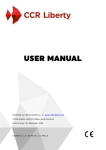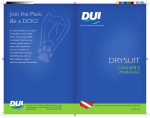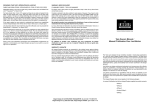Download "Seaskin User Manual"
Transcript
Seaskin Divewear User Manual www.seaskin.co.uk Issue 7 18/07/11 Aqualand Ltd Unit 4X, Hill Top Commercial Centre, Houghley Lane, Leeds, West Yorkshire, LS13 2DN, United Kingdom. Tel: 0113 2361776, Fax: 0113 2553777. [email protected] www.aqualandlimited.com Instruction Repair and Maintenance Manual 1. Safety 2. Sizing of Suits 3. Instructions for use 4. Care of Dry Suits 5. Care and use of Undersuits and thermal under garments 6. Care of neoprene products 7. Leak testing of suits 8. Drysuit repair 9. Tools materials and spares list 10. Seaskin (Aqualand Ltd) Service Department 11. Handling Glues and solvents 12. Warrantee 1. Safety Follow all instructions and heed these safety precautions. Improper use or misuse of a drysuit could result in serious injury or death. Diving This manual is NOT a substitute for drysuit instruction by a qualified instructor. DO NOT USE a drysuit until you have practised and mastered practical drysuit diving skills, including emergency skills, in a controlled environment under the supervision of a dive instructor, certified by a nationally recognised instructional organisation and knowledgeable in the use of drysuits. Observe the maximum depth limits according to the level of your training. Aqualand Ltd‟s drysuits have been used to 270mts. Improper use or misuse of a drysuit could result in loss of buoyancy control, including uncontrolled descents and uncontrolled rapid ascents, resulting in drowning, decompression sickness, or air embolism. Improper use or misuse of a drysuit could result in exposure to thermal hazards, including rapid body overheating or cooling, resulting in stroke or seizure. Do not use a drysuit as a lift bag. If you use a drysuit as a lift bag and lose your grip on the object, you may become excessively buoyant. This may result in a rapid ascent. Rapid ascent is dangerous and may cause air embolism or decompression sickness, either of which can result in serious injury or death. Diving in an environment which is chemically, biologically, or radiological contaminated is extremely hazardous. Although some equipment can be adapted for use in some contaminated environments, special training, equipment and procedures are required. Do not dive in a contaminated environment unless you have been thoroughly trained and specially equipped. Ice diving (diving in water 40°F (4.4°C) or less) is extremely hazardous. Do not engage in ice diving unless you have been thoroughly trained and specially equipped. 2. Sizing of Suits To check the size of the drysuit or undersuit, put on the drysuit over your thermal ware and complete the following fit evaluation: Feet should not feel cramped, or that the boot might slide of your foot. Ease of breathing: There should be no restriction when taking a deep breath. Overhead reach: Reach up with both hands, as if you were trying to reach the valve on your tank. Cross your arms reach: Reach across the chest with both arms (like you were hugging yourself.) You must be able to reach and operate the exhaust valve on the left shoulder. Crouch and reach: Kneel down, sit back over your heals and lean forward. This position checks the leg length and torso length at the same time. The drysuit should not be restrictive or binding. Latex neck and some wrist seals are capable of being trimmed to make them bigger.to provide a comfortable watertight seal. Latex neck and cone wrist seals are tapered and have a series of trim lines (small raised lines running around the outside surface of the seal.) The trim lines start at the seal opening and each line gets progressively bigger. These lines can be used as a guide when trimming the seals to keep the line even. A good pair of scissors is needed to make smooth cuts and not leave nicks in the seal that could course it to split. It is best not to trim the seals unless absolutely necessary. 3. Instructions for use Donning a Drysuit Drysuits are available in many different fabrics and zip positions but the procedure for putting them on is similar. Remove any jewelry or watches that may snag on the seals. Select the correct under clothing for the temperature conditions including socks/booties. Make sure any foot straps and thumb loops are used. Check the drysuit for any signs of damage, perished latex seals, broken zip, rips or holes in fabric etc and that if valves are fitted that they fully tightened. Hold the drysuit at its waist making sure that the braces if fitted are falling out side the legs. Pull on the bottom half of the suit like a normal pair of trousers up to the waist. If the suit is fitted with Latex or fabric socks, take care to avoid puncturing the soles by stepping on sharp objects or rough surfaces Pick up braces and loop over shoulders trying not to twist them so they lie flat against the body, adjust their length so the suit is pulled up comfortably to the crutch. If boots are not fitted put on suitable footwear taking care not to damage socks. Insert the right arm into the arm of the suit, point the fingers and use the other hand to help pass through the wrist seal gently as possible. The use of un-perfumed talcum powder (French chalk), soapy water or a water based lubricant ease the hands and head through both latex and neoprene seals, do not use any silicon based lubricants as this may make the suit un-repairable in the future. Make sure that the seal is seated flat and without folds against the skin, withdraw undersuit thumb loop in side suit and check no underwear is trapped. Repeat for the left arm. The neck seal opening should be opened gently using the fingers of both hands and then the head pushed through use lubricant if necessary. Adjust the neck seal so it sits against the skin untwisted and without folds. Neoprene necks are turned in to create the seal, make sure there is at least 60mm inverted. Great care should be taken when closing the zip; with across the shoulder designs the zip should be closed by another person. Do not use excessive force, it is very important that the under clothing is not caught in the zip as this will permanently damage it. Ensure that the slider is pulled straight along the chain. Do not force the slider forward over a point of resistance. Always double check that the zip or zips are fully closed before entering the water. Front and cross body zipped suits can be closed by the wearer. If a zip cover is provided this should be fixed into position. To remove air from the suit, insert fingers down the front of the neck seal and squat down keeping the arms in, air will rush out passed the seal, when air movement has stopped release the seal and then stand up. Remember to connect the low pressure hose from a regulated gas supply to the inflator valve. Put on gloves or hood if required. The suit should now prevent water ingress. Doffing a Drysuit Before undoing the zip rinse it with clean water to remove any sand or debris. When undoing the zip it is important to fully open it before getting out of the suit otherwise damage can occur. Reverse the above procedure using fingers to open the seals partially. It is often useful to have someone help in suit removal especially when fatigued. It is safer to sit down to remove the lower half of the suit to avoid a fall. Variable volume drysuit diving procedures Recommendations We recommend an approved dry suit diving course to start gaining knowledge. Start all dry suit exercise in shallow waters until you are confident in using the equipment. Accept training from experienced divers, ideally only from those who have obtained recognized diving qualifications. Make sure your equipment works as expected, otherwise abort your training. Proper weighting is extremely important. Knowledge and understanding of basic diving physiology is essential for optimal performance. The techniques for the control of buoyancy vary between training agencies. Suit valves are designed to provide buoyancy control on there own or in conjunction with a BCD or “wing”. Practice what you have been taught in a controlled water environment. Guidance for the use of variable volume valves 1. Make sure to check the valve attachment before diving. 2. Determine your insulation according to water temperature and adjust weighing accordingly. 3. Start fully equipped, enter into water not deeper than standing depth, for suit fitted with the automatic dump valves have the valve fully open, the lid turned counter clockwise to minimum internal pressure (-). Add weights until neutral, with the very top of the head just in the surface in an upright position. The valve should be at the highest position possible in the water (in comparison to the rest of the suit.) 4. Estimate the weight loss of the air consumed during your dive, compensate this plus a little extra lead weight (not more than 2 kg) in order to enable decompression stop, and/or to slow down the ascent speed. 5. Inflate the suit and adjust the dump valve clock wise in order to re-establish the neutral buoyancy. 6. To initiate a feet down descent, press the valve lid to reduce gas volume. During the descent, compensate for suit squeeze and buoyancy loss by inflating the suit. Settle yourself comfortably on the bottom in an upright position. Wind open the dump valve cap completely, blow air into the suit until it vents from the valve, close the cap one or two clicks at a time and press the inflator again. Repeat until sufficient buoyancy can be achieved to maintain a controlled rate of ascent without any assistance. As you ascend expanding air within the suit will be automatically vented. You may stop or slow down your ascent at any time by operating the manual push dump system. 7. In progressively deeper water practice buoyancy control by rolling, looping and hovering. Remember to exhale if ascending. 8. To recover from a feet first ascent, bend knees and body to obtain minimum length and rotate with the help of hands and strong fin kicks. In the upright position, stretch to allow gas to reach the exhaust valve for venting. 9. Ascending is controlled by the dump valve, if it is properly tuned and at the highest position. While diving, minor adjustments must be made by carefully setting the valve (weight lost due to air consumed). Adjusting the internal volume can also be made by pressing the lid or by raising the arm with the valve (for slower ascent speed) or lowering the arm (for faster ascent speed). Follow micro bubbles while ascending. Always ascend head up! When using Cuff dump valves, venting of the air is done simply by raising the arm and allowing the air to rise venting through the cuff dump valve. This type of valve is simpler than the auto dump valve, but does not offer the same control of buoyancy. Warnings 1. Unexpected buoyancy and ascent speed can be the result if any inflatable devise attached to the diver is inflated during diving. 2. Uncontrolled ascent speed can also be caused by slow permeable underwear. Breathable fabric does not always allow enough gas to reach the exhaust valve for control of ascent speed. Make sure that any clothing worn under a drysuit cannot interfere with the venting of air through the dump valve. 3. Avoid gas inflation into the suit when the feet are in a high position. 4. Make sure that the neck seal is the correct size for comfort. If it is too tight there is a risk for poor gas exchange in the blood vessels in the head. If it is too loose, the suit gas will not be retained in the suit. 5. Avoid jumping upright into the water. A „bottom first‟ or "giant step" entry will reduce the risk of creating too high pressure at the neck seal. 4. Care of Drysuits After use follow these maintenance procedures to ensure the optimum performance and extend the useful life of the drysuit. Having finished wearing the suit for the day, rinse the outside thoroughly with fresh clean water to remove any dirt, sand or salt. Any stubborn stains can be removed by rubbing the area gently with soapy water. If the zip is particularly dirty with sand or dirt after diving it can be cleaned by using an old toothbrush and fresh water (mild soapy water can be used for heavy soiling). After use, always rinse the inlet and outlet valves with cold running fresh water. To flush the inlet valve, simply connect the valve to an air supply and operate whilst flushing the push button area with water. This will help prevent sand and debris entering the valve seals. Check the drysuit for any signs of damage, perished latex seals, broken zip, rips or holes in fabric etc and that if valves are fitted that they fully tightened. Clean the Latex seals using cold fresh water. Latex seals will perish quickly if any kind of moisturising cream, body oils or oil is applied to them. After use clean the seals using mild soapy water to remove dirt and body oils. After you have rinsed out the suit, hang it over a drying rack or line in a shady spot. Ensure that the inside and outside are thoroughly dry. When dry Lubricate the zip or zips, any remaining Dirt and Debris must be removed first. The out side of the zip teeth should be rubbed down with the wax provided with the suit. The inside zip elements (where the seal is formed) should be lubricated with the special fluid. Apply the correct lubricant, open and close the zipper twice, then store the suit with the zipper open if stored in a bag or closed if hung using an appropriated coat hanger. It is important to do this - if not regularly lubricated the zip may seize up and fail. Latex seals should de dusted with talcum powder. The use of any product containing silicon on the drysuit could make the repairing and replacement of seals impossible due to its effects on adhesives. Consider whether any repairs are required or if a leak is suspected, see repair section. Storage of drysuits Once the drysuit valves are thoroughly clean and dry and the zip lubricated, you should store your drysuit in a cool dry place away from devices that produce ozone such as motors and heaters. It is preferable that the suit is stored hung up with the zip closed. Or packed correctly in the bag supplied with the zip open. When in storage or transportation do not allow the suit to be crushed by heavy weights. For long term storage of suits seal inside a polythene bag. Folding and packing To fold a dry suit for packing into a bag: For a back zip suit, lay the suit flat on the floor or large table with the front of the uppermost, the arms out at right angles and the zip open. Roll the suit up from the boots/socks up to the neck seal and then fold the arms over. This avoids folding the zip to sharply. For front zip suits start with back of the suit upper most and then follow the above. Slide the suit into the drawstring bag. Never store or transport a drysuit with a heavy weight on top of this as it may cause damage to the zip. To maintain optimal valve performance, we urge you to take good care of and treat your valve system just like you treat your breathing regulator. An annual check, by a recognised repair facility, of all your diving gear, including your dry suit valves, is recommended. 5. Care and use of Undersuits and Thermal Under garments Use the correct amount of insulation for the water/air temperature being exposed to and your exercise rate. Too much insulation can lead to dangerous overheating. Too little insulation can lead to the effects of hypothermia and death. Always ensure that body extremities are also well insulated, wear suitable gloves, hood/hat and socks or boots. All types of undersuit and thermal under garments can in some circumstance restrict the flow of air thorough the outlet valve. Manual manipulation of the drysuit/outlet and undersuit area should free any restriction of the airflow. If this does not clear it follow the emergency procedure below for "outlet valve stuck closed". EXHAUST VALVE STUCK CLOSED EMERGENCY PROCEDURE If the exhaust valve is stuck in the closed position or is blocked in some way, air cannot be properly vented from the drysuit. This may result in an uncontrolled ascent. If the exhaust valve is stuck in the closed position or blocked, either open the neck seal or a wrist seal to release air. Practise opening the seals on dry land when wearing the gloves and hood used during diving. When this emergency procedure is followed, some water will enter the drysuit. If sufficient air still cannot be vented and you are experiencing an uncontrolled ascent, flare your body to reduce the speed of the ascent. Spread your arms and legs away from your body, get your fins parallel to the surface of the water, and try to slow your ascent by creating drag. Be sure to continue exhaling as you ascend. Always be aware of any signs of lung over expansion injuries and decompression sickness and seek urgent medical attention if necessary. Care of Undersuits and Thermal Under garments After each days use hang the garment up to dry. Never hand wring a garment as this will damage any internal Thinsulate insulation and seriously impair its performance. If laundering is required follow the washing instructions carefully. These are normally as follows: Machine washing should be at a much-reduced cycle; the use of some fabric conditioners may impair the moister wicking properties of the fabrics. Spin dry and hang up to dry never wring out the water. Garments that are manufactured with 3M Thinsulate should not be tumble dried. Do not iron, dry-clean or use chlorine bleach. 6. Care of neoprene Products Products that are made from sponge neoprene such as hoods and gloves should be rinsed in clean freshwater after use and then left to dry on a suitable rack. Heavy soiling can be removed with a mild soap and gentle rubbing, rinse well in clean water and air dry at room temperature. Hand wash only. Machine washing will damage all neoprene products. Neoprene products should be stored in a cool dry place. Keeping them flat will avoid creases but these do not impair thermal performance. Do not store under heavy weights. Small holes or rips can be repaired with "wetsuit glue" available at dive shops, follow the instructions on the packaging. 7. Leak testing of Drysuits To test a drysuit for leaks; Turn the suit inside out. If the suit is fitted with an inflation valve unscrew it and reverse fit it so it is pointing inside the suit this enables an air supply to be attached. Close the zip by putting a hand in through the neck seal. Insert suitably sized cylindrical objects (5cm-8cm in diameter, at least 10cm long) into the wrist seals and secure them in place with PVC electrical insulation tape. Into the neck seal insert a cylindrical object (12cm-14cm in diameter, at least 15cm long) and secure with tape. Suits with no valves are best inflated by fitting a tool made for the purpose with a connector to match your supply, if a lot of testing of suits of any type is anticipated then this tool makes the job easier. Connect to the compressed air supply and carefully begin inflating the suit. The correct test pressure when testing in air 0.3 psi this can be estimated with out a gauge in the following ways. On suits with latex neck seal when its diameter expands to reaches 25cm. Or if it has neoprene seals when the neck seals just start to expand. Over inflating a suit can damage it. When the suit is inflated to the correct pressure use a sponge to cover it with soapy water, looking carefully for any bubbles being formed. Mark any leaks with a waterproof pencil. Keep topping up with compressed air if necessary. When finished testing remove from compressed air supply, rinse over with fresh water and allow the suit to deflate. Take great care when removing the electrical tapes so as not to damage the seals. Hang suit up to dry before attempting any repair. When refitting the inflation valve make sure it is refitted sufficiently tightly. 8. Drysuit Repair Basic repairs on drysuits are relatively easy if the correct materials and tools are used, if however the work is not carried out correctly then this may cause a failure of the suit during use. If in doubt about any work that needs to be carried out return the article to the Aqualand Ltd. The repairs that can be carried out by users are outlined below, we recommend that the replacing of dry zips and dry boots only be done by experienced workshops or they should be returned to the factory. It is essential when using glues and solvents that the necessary safety precautions are followed. We recommend that you use Bostik 2402 or Stormaprene, 2-part neoprene adhesive for repairs, but any neoprene based glue for marine use should be suitable. Use a toluene based solvent for cleaning and thinning adhesive. Repairing holes in neoprene drysuits is easier using Aquaseal urethane repair adhesive and sealant from McNett. Make sure that you request the Safety data sheets for these products and observe the handling, storage instructions and warnings. Mixing glue Bostik 2402 should be used as a two-part system; the correct ratio is 100:6 by weight (approx. 100:5 by volume) although we have found that this ratio does not have to be precise and can be judged by eye. If a thinner mixture is required add 20% SOLVENT. Stir very well with a mixing stick. If not mixing a full 250ml of glue in its can, then use mixing cups designed for the purpose or a clean and dry glass jar, do not mix in plastic cups as the solvents present will melt them. The pot life of mixed glue (parts A and B) is 6 hours at 20 C. Amount of glue required to: Repair a small hole 50 ml Changing a latex wrist seal and tape 75 ml Changing a latex neck seal and tape 75 ml Repairing a small puncture using a patch Locate the hole on the inside of the suit or bag. Clean around the area with solvent and allow to dry. Mix up the glue and paint on a coat of 60mm x 60mm square of glue using a brush. Cut a square of neoprene tape 38mm x 38mm. Coat the textured side of the tape with glue. When the first coat of glue is touch dry (10-15mins) apply a second coat to suit and tape. When the second coat is touch dry place the patch over the puncture, trying not to trap air bubbles. Roll the patch down with a small hand roller using firm pressure. Dust the area with talc. The suit can be used in 1 hour with care, but full strength is after 24 hours. If material has been lost from the damaged area or if it is a slit more than 10mm long then a patch of suit material must also be glued to the out side of the suit to maintain structural strength. Use an appropriate sized neoprene tape patch on the inside of the suit. Repairing a small puncture using Aquaseal Repairing punctures in neoprene suits is often easier using Aquaseal urethane repair adhesive and sealant although cure times are longer if Cotol -240 accelerator is not mixed at 10:1 ratio. Locate the hole on the inside of the suit. For a neat repair cut a 20mm hole out of a length of 50mm polypropylene packing tape. Stick on the tape strip so the puncture is in the center of the hole. Keep the area of the repair level. Apply the Aquaseal so as to fill the hole in the packing tape and over its edge. Leave to cure for 2 hours if Cotol was used, 10-36 hours if not. Then peal away the packing tape to leave a 20mm repair circle. Packing tape does not have to be used, and sealant can be applied directly straight from the tube. Changing a latex wrist seal glued to the inside of the suit You can either remove the old seal entirely, or cut the old seal off at the edge of the suit, leaving a band of the old rubber still glued to the suit. If you cut the old seal off, be careful not to cut the suit. You will be gluing the new seal over the band of old rubber. If removing the whole seal simply soften the glue by the gradual application of heat, or solvent. Either process will cause the glue to soften, and the old seal can be peeled off carefully. Heat can be applied with a hair dryer or hot air paint stripper on its lowest setting. Be careful not to burn your fingers or the suit. Using long nosed pliers or forceps will make this easier. Turn the arm of the suit inside out. Insert the wrist seal repair former down into the sleeve of the drysuit, allowing the former to stick out about 25mm through the end. To create a firmer fit in the sleeve, the former can be forced open further by inserting a suitably sized wedge down the slot. Turn the seal inside out, the shiny side is the outside of the seal and the duller side the inside of the seal that when wearing is against the skin. Position the new seal over the end of the former and on the sleeve where it will be glued. Using the old glue line or old seal as a guide to how far up it should go. Use masking tape around the seal (below the sleeve) to hold it in position on the former. Apply masking tape around the sleeve at the top of the gluing area, and on the new seal, behind the folded back portion. This will keep excess glue from running down and messing up the suit or the seal. Fold the edge of the new seal back down the former so that both the seal and the suit areas to be glued are exposed light rubbing with sand paper will give a better key for the glue onto the seal, then wipe over with solvent. Practice rolling the seal back up the sleeve to ensure that it finishes in the correct position. Mix up the BOSTIK 2402 or Stormaprene glue as instructed above. Coat the areas to be glued on suit and seal with BOSTIK 2402 or Stormaprene using a brush. Leave until to become touch dry, about 10-15 minutes. Apply a second coat and allow to become touch dry. Roll the folded edge of the seal down over the sleeve, if this is done evenly and without stretching the seal it will finish in the correct position. Use the roller to gently work out any bubbles or wrinkles, making sure the seal fits smoothly on the sleeve. The seal should remain on the former for at least 1 hour to allow the glue to cure. Once the glue is dry, remove the former carefully. If the seal has stuck to the former use a brush soaked in solvent to dissolve away the glue. Check the edges of the seal by picking at them with your fingernails. If any area comes up, reapply a small quantity of glue to the lifting area. Excess glue can be rubbed off with a little solvent on a cloth. Dust the area with talc. Suit can be used in 3 hours with care, but full strength is after 24 hours. Changing a latex wrist seal glued to the outside of the suit and taped You can either remove the old seal and tape entirely, or cut the old seal off at the edge of the suit, leaving a band of the old rubber still glued to the suit. It is usually best to remove the tape from the inside suit that is over the suit and seal joint. To remove tape start at the glued down end and apply heat by using a hair dryer or hot air paint stripper on its lowest setting. Be careful not to burn your fingers or the suit. Using long nosed pliers or forceps will make this easier. Once the end is loose work back along the tape trying not to pull so hard as to break it. Be careful not to burn your fingers or the suit with to much heat. If you cut the old seal off, be careful not to cut the suit. You will be gluing the new seal over the band of old rubber. If removing the whole seal simply soften the glue by the gradual application of heat, or solvent. Either process will cause the glue to soften, and the old seal can be peeled off carefully. Much more care must be taken when working with neoprene suits as the nylon burs more easily and if too much solvent is used then the nylon will delaminate from the neoprene center. Insert the wrist seal repair former down into the sleeve of the drysuit, allowing the former to stick out about 25mm through the end. To create a firmer fit in the sleeve, the former can be forced out further by inserting a suitably sized wedge down the slot. Make sure that the seal is the right way round. The shiny side is the outside of the seal and the duller side the inside of the seal that when wearing is against the skin. Position the new seal over the end of the former and on the sleeve where it will be glued. Using the old glue line or old seal as a guide to how far up it should go. If you are reapplying 25mm tape then position the seal 12.5mm below the glue line. Use masking tape around the seal (below the sleeve) to hold it in position on the former. Apply masking tape around the sleeve at the top of the gluing area, and on the new seal, behind the folded back portion. This will keep excess glue from running down and messing up the suit or the seal. Fold the edge of the new seal back down the former so that both the seal and the suit areas to be glued are exposed. A light rubbing with sandpaper will give a better key for the glue onto the seal, then wipe over with solvent. Practice rolling the seal back up the sleeve to ensure that it finishes in the correct position. Mix up the BOSTIK 2402 or Stormaprene glue as instructed above. Coat the areas to be glued on suit and seal with BOSTIK 2402 or Stormaprene using a brush. Leave until to become touch dry, about 10-15 minutes. Apply a second coat and allow to become touch dry. Roll the folded edge of the seal down over the sleeve, if this is done evenly and without stretching the seal it will finish in the correct position. Use the roller to gently work out any bubbles or wrinkles, making sure the seal fits smoothly on the sleeve. If required the suit/seal edge should be over taped. Cut a piece of 25mm tape to the correct length, allowing a 20mm overlap. A 30mm band should be coated with glue centered on the top edge of the seal also coat the cut tape on the textured side. Allow glue to become touch dry and then re-coat. Wrap the tape around in the correct position. Apply some glue to the area below the overlap, and stick down when touch dry. The seal should remain on the former for at least 1 hour to allow the glue to cure. Once the glue is dry, remove the former carefully. If the seal has stuck to the former use a brush soaked in solvent to dissolve away the glue. To tape the seal joint turn the suit inside out and repeat the process for taping above after wiping the area with solvent. The seal should remain on the former for at least 1 hour to allow the glue to cure. Once the glue is dry, remove the former carefully. Check the edges of the seal and tapes by picking at them with your fingernails. If any area comes up, reapply a small quantity of glue to the lifting area. Excess glue can be rubbed off with a little solvent on a cloth. Dust the area with talc. Suit can be used in 3 hours with care, but full strength is after 24 hours. Apply masking tape around the sleeve at the top of the gluing area, and on the new seal, behind the folded back portion. This will keep excess glue from running down and messing up the suit or the seal. Fold the edge of the new seal back down the former so that both the seal and the suit areas to be glued are exposed and wipe over with solvent. Practice rolling the seal back up the sleeve to ensure that it finishes in the correct position. Mix up the BOSTIK 2402 or Stormaprene glue as instructed above. Coat the areas to be glued on suit and seal with BOSTIK 2402 or Stormaprene using a brush. Leave until to become touch dry, about 10-15 minutes. Apply a second coat and allow to become touch dry. Roll the folded edge of the seal down over the sleeve, if this is done evenly and without stretching the seal it will finish in the correct position. Use the roller to gently work out any bubbles or wrinkles, making sure the seal fits smoothly on the sleeve. The seal should remain on the former for at least 1 hour to allow the glue to cure. Once the glue is dry, remove the former carefully. If the seal has stuck to the former use a brush soaked in solvent to dissolve away the glue. Check the edges of the seal by picking at them with your fingernails. If any area comes up, reapply a small quantity of glue to the lifting area. Excess glue can be rubbed off with a little solvent on a cloth. Dust the area with talc. The suit can be used in 3 hours with care, but full strength is after 24 hours. Changing a latex Neck Seal Whether the neck seal has been glued on the inside or out side of the suit the principles the same. You can either remove the old seal and tape entirely, or cut the old seal off at the edge of the suit, leaving a band of the old rubber still glued to the suit. It is usually best to remove the tape from the inside suit that is over the suit and seal join. To remove tape start at the glued down end and apply heat with a hair dryer or hot air paint stripper on its lowest setting. Be careful not to burn your fingers or the suit. Using long nosed pliers or forceps will make this easier. Once the end is loose work back along the tape trying not to pull so hard as to break it. Be careful not to burn your fingers or the suit with to much heat. If you cut the old seal off, be careful not to cut the suit. You will be gluing the new seal over the band of old rubber. If removing the whole seal simply soften the glue by the gradual application of heat, or solvent. Either process will cause the glue to soften, and the old seal can be peeled off carefully. Much more care must be taken when working with neoprene suits as the nylon burns more easily and if too much solvent is used then the nylon will delaminate from the neoprene center. Inserting a piece of cardboard or wood inside the suit makes gluing easier and prevents glue getting were it is not wanted, the neck hole of the suit can be held to the board by double sided tape. If a neoprene hood is attached then this should be turned inside out or a board with a hole cut in it used. Make sure that the seal is the right way round. The shiny side is the outside of the seal and the duller side the inside of the seal that when wearing is against the skin. Position the new seal on to the neck seal former using double sided tape to keep it in position make sure that the edge of the is pulled out to the edge of the ring. A light rubbing with sandpaper will give a better key for the glue, then wipe down with solvent. Practice positioning the new seal on its ring onto the suit draw round the ring to give a guide to glue to, add 12.5mm all around if 25mm tape is to be added around after. Mix up the BOSTIK 2402 or Stormaprene glue as instructed above. Coat the areas to be glued on suit and seal with BOSTIK 2402 or Stormaprene using a brush. Leave until to become touch dry, about 10-15 minutes. Apply a second coat and allow to become touch dry. Lower the former ring with attached seal down into the correct position, press down hard to get the glue coats to bond, peel the ring away carefully Use the roller to gently work out any bubbles or wrinkles, making sure the seal sits flat on to the suit. If required the suit/seal edge should be over taped. Cut a piece of 25mm tape to the correct length, allowing a 20mm overlap. A 30mm band should be coated with glue centered on the top edge of the seal also coat the cut tape on the textured side. Allow glue to become touch dry and then re-coat. Wrap the tape around in the correct position. Apply some glue to the area below the overlap, and stick down when touch dry. The seal should remain on the board for at least 1 hour to allow the glue to cure. Once the glue is dry, remove the board carefully. If the seal has stuck to the former use a brush soaked in solvent to dissolve away the glue. To tape the seal joint turn the suit inside out and repeat the process for taping above after wiping the area with solvent. Check the edges of the seal and tapes by picking at them with your fingernails. If any area comes up, reapply a small quantity of glue to the lifting area. Excess glue can be rubbed off with a little solvent on a cloth. Dust the area with talc. Suit can be used in 3 hours with care, but full strength is after 24 hours. Fitting valve patches The fist job is to get the position for the new valve by putting the drysuit and any BCD or harness on so as to avoid interference. Inflators are normally mounted in the centre or offset to one side to avoid the middle seam. Automatic dump valves are normally placed on the upper left arms slightly forward facing for easy manual operation and adjustment. The suit should be clean and dry before any work is carried out. Use the patch as a template and draw round it with chalk. A coat of Bostik 2402 or Stormaprene glue mixed according to the instructions is applied by brush to the suit and left to dry. Apeks patches (AP0166) should be rubbed down with sand paper first and a coat applied and left to dry. Three coats on the suit and two coats on the patch. The final coats should be left until they are tacky but not stringing away when touched. Press the patch into position (be accurate repositioning is not possible) as hard as you can, leave to dry with a weight on top for at least 2 hours, ideally leave the suit to cure for 24 hours before cutting the hole out with a sharp knife. SITECH valve patches (#60852) are mounted internally and the hole is cut before gluing takes place. These valves require a PU based glue such as Bostik 3206. Cut a hole 34mm in the suit (neoprene drysuits over 5mm thick should use an externally fitted patch) coat the INSIDE of the suit (the cut hole sides on neoprene suits), the upper surface and lips of the patch, three coats each letting them dry between coats. When the glue is dry insert the patch through the hole, then a hair drier set to hot can be used to heat the glue layers. When hot (careful not the scorch the fabric of the suit) they can be pressed together and left to cool with a weight on top. The valves can be screwed into place, on neoprene suits for the first couple of months they need to be retightened as the neoprene compresses down. It is good practice to check the tightness of valves as part of the routine maintenance of your diving equipment. 9. Tools, Materials and Spares List Drysuit pressure testing kit (Shreader valve) - Neck seal bung with inflation valve and two wrist seal bungs suitable for dive centers and schools. Drysuit pressure testing kit (valve with CEJN male coupling) - Neck seal bung with inflation valve and two wrist seal bungs. Drysuit pressure testing kit (valve Seatec male coupling) - Neck seal bung with inflation valve and two wrist seal bungs. Wrist seal fitting former Plywood ring for latex neck seal fitting Hand roller (rubber) Brushes for glue 12mm Mixing Cups 250ml Masking tape 25mm PVC insulation tape 25mm x 25mt Packing tape 50mm x 50 mt Double sided tape 25mm x 25mt Chalk for marking Sand paper Wax blocks Talc bottles Glue Bostik 2402 parts A and B 250ml Stormaprene Glue Bostik 3206 Aquaseal 226.8g Cotol -240 accelerator Neoprene tape 38mm x 50 mt Neoprene tape 25mm x 50 Mts. Drysuit repair Fabric (various) Neck seal latex size Medium/Large Neck seal latex size Small Neck seal latex size Extra Small Heavy Duty Neck seal latex size Medium/Large Heavy Duty Neck seal latex size Small Heavy Duty Neck seal latex size Extra Small Wrist seals latex bottle shape size XL, pair Wrist seals latex bottle shape size L, pair Wrist seals latex bottle shape size M, pair Wrist seals latex bottle shape size S, pair Wrist seals latex bottle shape size XS, pair Heavy Duty Wrist seals latex bottle shape size XL, pair Heavy Duty Wrist seals latex bottle shape size L, pair Heavy Duty Wrist seals latex bottle shape size M, pair Heavy Duty Wrist seals latex bottle shape size S, pair Heavy Duty Wrist seals latex bottle shape size XS, pair Wrist seals latex cone shape size standard, pair Wrist seals latex cone shape size extra small, pair Wrist seals latex bottle shape Beaded for cuff rings size standard, pair Wrist seals latex bottle shape Beaded for cuff rings size extra small, pair Boots drysuit Neoprene sizes 4-11(UK) Boots drysuit TDX sizes 4-12 (UK) Socks latex (pair) sizes S,M,L,XL Dry zips BDM - contact for details 10. Seaskin (Aqualand Ltd) Service Department Seaskin (Aqualand Limited) service/warranty department can perform testing and repairs on neoprene and membrane drysuits and bags from most manufacturers. Contact [email protected] for details or call 0113 2361776. Also we can run drysuit service/repair courses if required. 11. Handling Glues and solvents ALWAYS READ THE INSTRUCTIONS FOR USE, HANDLING AND STORAGE OF ALL GLUES AND SOLVENTS. BE AWARE OF THE POTENTIALS HAZARDS. 14. Warranty Seaskin drysuits and undersuits are produced by AQUALAND LTD. AQUALAND LIMITED warrants that your AQUALAND LIMITED drysuit (except for neck seals, wrist seals, zipper and valves) will be free from defects in materials and workmanship for a period of two years from the date of original retail purchase. AQUALAND LIMITED warrants that the zipper, the exhaust valve, and the inlet valve will be free from defects in materials and workmanship for a period of one year from the date of original retail purchase. AQUALAND LIMITED warrants that latex seals and socks will be free from defects in material and workmanship for a period of ninety (90) days from the date of original retail purchase, any use of silicon products will invalidate the warranty. Any product determined by AQUALAND LIMITED to be defective in materials or workmanship in accordance with the above warranties will be repaired or replaced at the option of AQUALAND LIMITED, free of charge, when received at the factory, together with proof of purchase. This warranty is expressly in lieu of all other warranties. Any implied warranties of merchantability or fitness for a particular purpose are limited to the same duration as this express warranty. This warranty does not cover any damage resulting from misuse, abuse, neglect, alteration, failure to perform maintenance as instructed, damage caused by contaminants, or unauthorised repair or service. This warranty does not cover costs incurred for normal repair, inspection and preventive maintenance. This warranty is a consumer warranty extended only to the original retail Purchaser. Your statutory rights are unaffected. Aqualand Limited Warranty (Part of Conditions of Sale) “the Seller” means Aqualand Ltd. 8.1 The Seller warrants (subject to the limitations set out in Conditions 8.2 and 9 below) that if Goods of the Seller's own manufacture (but excluding constituent parts of the Seller's suppliers or sub-contractors) or provided by the Seller prove under normal conditions not to be free from defects in workmanship and if the conditions set out below are each satisfied the Seller shall (at its election) repair or replace free of charge any Goods (or the relevant constituent parts not being expendable items) which the Seller shall find upon examination (for which the Buyer will provide full facilities) to have been so defective. The said conditions (each of which must be fulfilled before any warranty claim shall arise) are: 8.1.1 that the claim is not attributable to fair wear and tear or any fault or damage arising from impact, modification, inappropriate use or treatment, incorrect handling or exposure to corrosive substances or substances otherwise injurious to the Goods or their constituent materials; 8.1.2 that the claim is made by the Buyer as the Seller's original customer for the Buyer's own benefit; 8.1.3 that the claim is notified (in detail) in writing to the Seller within 30 days of the date of discovery thereof and in any event within 12 months of delivery; 8.1.4 that the Seller's recommendations for installation, maintenance, storage use and follow-up in respect of its Goods have been complied with. 8.2 Except where the Seller specifically otherwise agrees in Writing, the Seller offers no (and shall have no liability under any) warranty or condition (express or implied) in respect of goods, materials or services of its suppliers or sub-contractors but the Seller will if requested by the Buyer (and if the Seller considers it appropriate and practical to do so) assist the Buyer to obtain the benefit of such warranties as are available from them in favour of first users or goods or services.





















